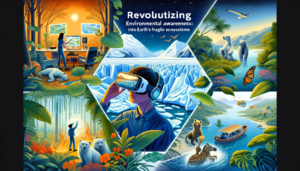Introduction: The Combination of Knowledge about the Environment and Innovation
The launch of this project will lay the groundwork for integrating environmental education with virtual reality (VR) technologies. It will draw attention to the growing need for creative ways to spread information concerning the planet’s delicate ecological systems and how virtual reality presents an undiscovered means.
The Development of Virtual Environment Research
The development of VR as a tool for environmental exploration will be covered in detail in this section. It will follow the story of virtual reality (VR) from a new gaming technology to an effective teaching tool, highlighting how VR may improve our comprehension of the natural world.
Simulated Visits to Various Ecosystems
This article will examine many virtual reality experiences that let readers virtually visit a variety of habitats. This section will show how virtual reality (VR) may transport viewers to isolated locations, such as the heights of rainforests or the ocean’s depths, allowing them to develop a stronger bond with the natural world.
VR Perspective on Climate Change Visualization
We’ll talk about how VR is ideally positioned to illustrate the effects of climate change in this part. It will explore a range of virtual reality projects that bring pollution, deforestation, and global warming to life, giving abstract ideas a concrete, instantaneous presence.
Wildlife and Preservation in Virtual Reality
The remainder of this article will look at how the technology known as virtual reality (VR) can be used to bring visitors up close and personal with animals, especially species that are threatened or hard to spot in the wild. It will discuss how these comprehensive experiences might foster empathy and a deeper understanding of the need for conservation.
Virtual Reality as a Teaching Revolution in Science and Environmental Education
The use of VR in educational contexts will be covered in detail in this section. It will discuss how educational institutions utilize virtual reality (VR) to deliver environmental science and ecology courses more captivating and meaningfully, emphasizing immersive learning opportunities.
Behind the Scenes: Crafting Virtual Reality Environments
This article will examine the process of producing virtual reality environmental experiences. It will examine how environmental scientists, technologists, and educators collaborated to create these virtual environments, highlighting the creative and technological difficulties encountered.
Practical and Ethical Aspects to Consider
We’ll talk about the moral ramifications of virtualizing nature in this part. It will go over how to simulate natural settings without undermining the significance of actual conservation initiatives.
Virtual Reality’s Potential for Environmental Awareness
This section will provide predictions about VR’s potential application in environmental activism. Potential technical developments will be covered, including integrating augmented reality (AR) and the growing influence of virtual reality (VR) experiences on public opinion and environmental policies.
Case Studies: Virtual Reality’s Effect on the Environment
This article will showcase effective virtual reality initiatives that have enhanced environmental consciousness and activism. These case studies will show how involvement with and modifying the natural environment can result from virtual experiences.
Conclusion: Leaning Towards a Greener Future with VR
The final section will summarize the main ideas and highlight how VR might revolutionize environmental campaigning and awareness. It will present a progressive perspective on how adopting VR can result in a more aware and educated society about ecological issues.
This thorough investigation will shed light on the state of virtual reality in environmental awareness today and explore its potential for the future, highlighting the technology’s ability to fundamentally alter how we interact with and comprehend Earth’s ecosystems.
